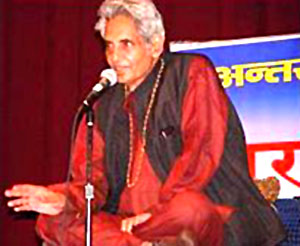 Poet Gopaldas Neeraj has played a vital role to the world of Hindi cinema with extraordinary lyrics. He has been honoured with a Padma Shri from the Government of India, Yash Bharti by the government of Uttar Pradesh, Rajat Shree by the Hindi Samaj Australia and also Filmfare Award for Best Lyricist. Here is a poet who confirms that he gave utmost importance to words in his life and words are still a symbol of his existence.
Poet Gopaldas Neeraj has played a vital role to the world of Hindi cinema with extraordinary lyrics. He has been honoured with a Padma Shri from the Government of India, Yash Bharti by the government of Uttar Pradesh, Rajat Shree by the Hindi Samaj Australia and also Filmfare Award for Best Lyricist. Here is a poet who confirms that he gave utmost importance to words in his life and words are still a symbol of his existence.
Gopaldas Neeraj was born in the small village, Puravali of Etawah in Uttar Pradesh, India. He studied till high school at the Government College at Etah in Uttar Pradesh, and then studied until M.A. at the D.A.V. College in Kanpur. He wrote impressive verses under the pen name "Neeraj". His style is easy to understand, but has also been compared with high quality Hindi literature. Besides writing, he earned his living by teaching in a college. He was a well-known Professor of Hindi Literature in Aligarh (U.P.) University. Majority of his poems and songs have been used in Hindi movies and are considered to be famous. He wrote songs for several Hindi Movies and attained an exceptional position as a songwriter who wrote in pure Hindi and did not support Hindi-Urdu mix, which is becoming more common day by day. He writes in a manner that is often marked by an impeccable lyrical quality.
Neeraj`s poetic canvas is decorated with an overdose of symbols that are fresh, inspirational and unique from numerous perspectives. One of the reasons why his poetry struck a chord with the readers is that his verses came straight from the heart, which though used sensuality as a tool were aimed at creating a better space within an individual. Fortunately, he managed to make his presence felt in Indian movie world which allowed him to unleash his creative energy for a wider circle of admirers.
He was highly influenced by the verses of Shri Harivansh Rai Bachchan. He came into limelight for the first time in 1941 when he recited his compositions at a kavi sammelan in Etah. He entered films in I960, when the late R. Chandra, producer and director, invited him to write songs for his picture Nai Umar Ki Nai Fasal. He also wrote the lyrics for films like Mera Naam Joker, Prem Pujari, Sharmilee, Pehchan, Chanda Aur Bijli, Tere Mere Sapne, Kanyadan, and Gambler.
His simplicity of style made him a charisma, a darling of the masses.
"Itne badnam hain hum to iss zamaane mein, tum ko lag jayengi sadiaan hum ko bhulane mein"- these lines by poet Gopal Das Neeraj sum up his more than seven-decade-long tryst with pen.



















